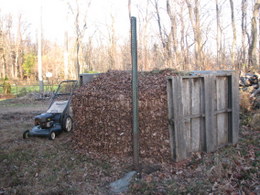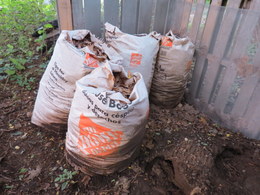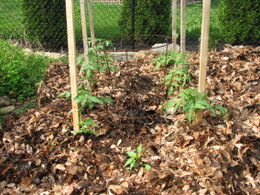Mulch Your Plants
For mulch you can use shredded leaves, straw or spoiled hay, pine straw as well as most any plant-based material that decomposes. Thin layers of grass caught from your mower can be used, but thick layers of freshly mowed grass clippings piled in one spot will become moldy and slimy. Fresh hay may contain many weed seeds.
Shredded leaves picked up by your mower are among the best types to use. Tree leaves are very plentiful in the fall and they are free. Large leaves such as from oak or maple trees should be shredded before adding to your compost pile. The large leaves form a thick dense mat that does not allow water to penetrate properly.
They can be shredded by mowing and bagging with a lawn mower or garden tractor with grass catcher or bagger attached and you are all set to go collecting your mulch. The shredded leaves mixed with the grass clippings will make the best leaf mold mulch to place around your newly planted vegetables in the spring. All you need is a place near your garden to put your shredded leaves to store them over the winter.
Many towns have stopped picking up leaves by vacuuming them up from the street. Many places now require that the leaves be placed in large paper leaf bags and to be placed by the curb for pickup. Many of these homeowners will be happy to give them to you if you do not have enough leaves from your trees.
What if you live in an area that does not have hardwood trees and all you have are pine trees? The pine needles, which are often called pine straw, will also make great mulch that also looks very nice. Pine straw from Longleaf Pine, Slash Pine and Loblolly Pine are often sold by the bale in garden centers as well as other distributors. The wax coating also causes them to break down more slowly than hardwood leaves.
Mulching Benefits

The many benefits are: weed control, moisture retention, soil temperature and soil structure.
An added benefit is that the mulch will break down over time and improve your garden soil.
Weed Control

Many gardeners think that mulching a vegetable garden or flower bed is a lot of work, but in the long run it will save you a lot of time. A 2 or 3-inch layer will prevent the growth of many weeds that want to take over your newly planted vegetables and crowd them out. The mulch blocks sunlight which prevents the weeds from sprouting. The physical barrier will smother most weeds that do sprout. Once you get started your garden and see the benefits and how much work it saves you, you will never go back to gardening with bare soil.
A layer around the plants will keep at least 90% of the weeds down. It also lowers the soil temperature and slows down the rate of water evaporation. It is important that it is not piled right up to the base of the plant. It is a good practice to keep the mulch about 2-inches from the plant so that the crown does not get covered. Any weeds that do show up can be easily pulled out and left on top to dry out and die.
Corn gluten is widely used as a weed control. It does not kill weeds so it is necessary to do your weeding first. It works by preventing the germination of seeds.
Many gardeners use black plastic to block the growth of weeds. After your planting bed is prepared, the black plastic is rolled out over it. To keep it from blowing it away it needs to be well anchored around all sides. It does help to warm the soil. Slits are made in the plastic in the locations where you want to place your plants.
Another solution that really works to block weeds is using old carpets. It does very well in the aisles that get walked on a lot. The carpet is easy to cut with a utility knife into long strips of the width you need. The easiest way to cut the carpet is to place the carpet on your lawn, with the backing side up and using a tape measure or yard stick, mark where you want to cut it. It will last many years and can be moved from one place to another as needed. In the fall the carpet can be shaken out over the lawn and rolled up and put away for next year.
Raised beds are a good place to use old carpets. For example if your raised bed is 4-foot by 4-foot you can cut a piece 2-foot by 4-foot to block off half of the raised bed. Early in the spring you may plant lettuce in half of the bed with the carpet covering the other half. When the lettuce is almost finished all you need do is to remove the carpet from the weed-free half and sow the seeds for your next crop of lettuce.
Moisture Retention
A layer of mulch allows water to pass through the mulch and get to the soil and on down to the roots. It forms a protective layer and slows the evaporation of moisture from the soil surface. This will save water by reducing the amount of water you need to give your plants. The soil beneath the layer will stay moist and friable allowing the roots to grow easily and take in needed nutrients.
Soil Temperature
Mulch helps regulate the soil temperature at the root zone of your plants. It keeps the soil from getting too hot from the sun and at night the mulch acts like insulation to keep the soil warm at night.
On a warm sunny day pull back the mulch and touch the soil to see how good it feels.
Soil Structure
Mulching improves the soil structure and what the soil experts call soil tilth. As it breaks down the organic matter is incorporated into the soil. This releases some of the nutrients that were in the mulch and now can be recycled and now be made available to your new plants.
Mulching Flower Beds
Mulching your flower beds or the aisles between your raised beds with shredded wood mulch is a more permanent method to deter weed growth. In addition to discouraging the growth of weeds it beautifies your landscaped areas. The shredded mulch allows water to pass through the mulch and it blocks the light many weeds need to germinate.
Brown, black and red shredded mulch are the most common colors found in garden centers and will still look good after a year or more.
When buying shredded wood mulch always look for the Mulch and Soil Council certification seal on the package. This certification insures that the shredded mulch does not contain any treated wood that may contain arsenic or lead paint.
Be cautious when buying in bulk by the truck load. Ask to see the certification before you have it delivered.
Garden centers also may sell shredded rubber mulch. It really does not belong in your garden since it does not work in the same way as natural mulch. If you decide that you do not like the rubber mulch it is a big job to get rid of it.
Garden Spikes newsletters give you timely information once or twice a month. Subscribe Free to the Garden Times newsletter below.
Your email address will only be used to send you a newsletter and will never be sold. You can unsubscribe at any time.

